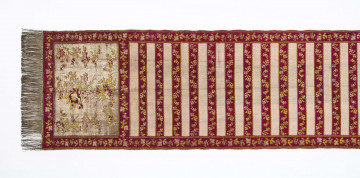
One-sided kontusz belt
1766 — 1788
National Museum in Lublin
Part of the collection: Textiles, embroideries, clothing and costume accessories of the 16th–19th c.
The term Słuck belt is often used as a synonym for a robe (kontusz) belt. The Radziwiłł's estate in Słuck was home to Poland's oldest and most highly regarded belt factories, a sash manufactory. Its fame was due to the high quality and extraordinary beauty of the colourful silk belts woven there. The designs of the fabrics were inspired by Persian patterns, as well as those taken from fashionable Western European silks. Initially, the weaving workshop founded by Michał Kazimierz Radziwiłł operated in Nieśwież, before moving to Słuck. From 1758, Jan Madżarski, formerly known as the 'master of Persian work' at the Stanisławów factory, became its manager. He came from an Armenian-Hungarian family that found itself in turmoil in Constantinople. His longing for his family was supposedly the reason for his unsuccessful escape from the Radziwiłł's estate. Michał Radziwiłł, who valued his employee and understood the motives of this wilfulness, brought his relatives to Poland. The fate of Jan Madżarski's estates was equally turbulent. A local troublemaker usurped his rights, but the property problems were resolved successfully with Radziwiłł's help. Despite various perturbations, Madżarski managed the manufactory efficiently. In 1767, 245 girdles were made, while between 1767 and 1776, as many as 758 were manufactured. Luxury products were intended for the owner of the Persian dynasty, while the production of more modestly decorated items served the Radziwiłłs' courtiers. Numerous fabrics produced over and above the needs of the Radziwiłł's house were sold to the Lithuanian and the Crown nobility. The profits allowed for the continuous development of production. The factory manager soon became its lessee. The prosperity continued after 1780, when Jan's son, Leon, took over the sash manufactory. The belts of fixed composition and rich colours were woven from silk, with gold or silver thread added. Although they were objects of daily use, they have survived in many collections. The National Museum in Lublin possesses a silver, four-sided belt with decoration referring to West European floral motifs. The colours of the silk enchant with their beauty to this day. Its first owner undoubtedly treasured it and used it often, as evidenced by the numerous smudges and scuffs on this beautiful Słuck robe belt.
Magdalena Norkowska
Author / creator
Dimensions
cały obiekt: height: 360 cm, width: 30 cm
Object type
a contoured belt
Technique
weaving
Material
silk (natural fabric), silver metal thread
Creation time / dating
Creation / finding place
Owner
The National Museum in Lublin
Identification number
Location / status

1766 — 1788
National Museum in Lublin

1789 — 1793
National Museum in Lublin

1781 — 1806
National Museum in Lublin
DISCOVER this TOPIC
National Museum in Szczecin
DISCOVER this PATH
Educational path